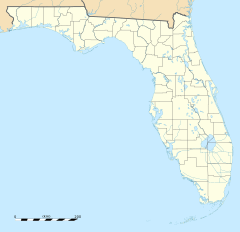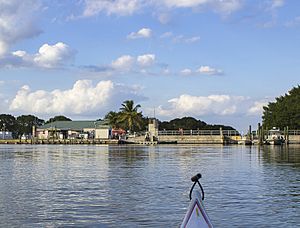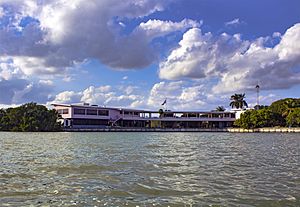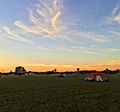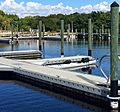Flamingo, Monroe County, Florida facts for kids
Quick facts for kids
Flamingo
|
|
|---|---|
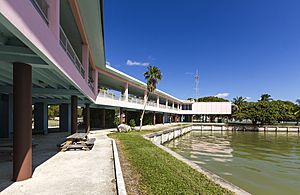
Flamingo Visitor Center
|
|
| Country | United States |
| State | Florida |
| County | Monroe |
| Time zone | UTC-5 (Eastern (EST)) |
| • Summer (DST) | UTC-4 (EDT) |
Flamingo is a special place located at the very southern tip of Florida. It's the main office for the southern part of Everglades National Park in Monroe County. Flamingo is also where the 99-mile (159-km) Wilderness Waterway ends. This waterway is a path for boats through the park. It's also the end of the only road that goes through the park from Florida City.
Flamingo started as a small village on the eastern side of Cape Sable. This area faces Florida Bay. The original town of Flamingo was about 4.5 miles west of where the Flamingo campground is today. Now, only a few old building parts are left, and it's known as a ghost town.
Contents
Flamingo's Early Days
Flamingo was first settled around 1892. Before that, Tequesta Native Americans lived in the area. The early settlers made a living by catching fish, growing fresh vegetables, and making charcoal. They sold these goods to people in Key West.
How Flamingo Got Its Name
The settlement got its name in 1893. The settlers needed to choose a name for their new post office. They picked the flamingo because it was a very special bird often seen there. Even though flamingos didn't nest in Florida, many birds from Cuba and the Bahamas used to visit the area. The last time many flamingos were seen here was in 1902. The post office closed in 1909.
Life in Old Flamingo
Life in Flamingo could be quite tough. A naturalist named Leverett White Brownell visited in 1893. He said the village had 38 small houses built on stilts. He described them as being full of fleas and mosquitoes. He even said he saw a cloud of mosquitoes put out an oil lamp! He also mentioned that flea powder was very important. The houses were dark from using "smudge pots" to keep bugs away. Tomatoes, asparagus, and eggplant were the main crops grown there.
A Small Boom and Bust
Flamingo had a short period of growth in the early 1900s. People thought that Henry Flagler would build his Florida East Coast Railway through Florida Bay to Key West. By 1900, about 50 families lived in Flamingo, and it even had a school.
Nearby bird nesting areas, like the famous Cuthbert Rookery, became popular with poachers. Poachers are people who illegally hunt animals. They killed the nesting birds for their beautiful feathers, which were used to decorate women's hats.
A fish house was built in Flamingo in 1908, and fishing became the main job. But by 1910, only three homes were still lived in. The Ingraham Highway from Homestead reached Flamingo in 1922. However, it was often in bad shape and hard to use when it rained. The National Park Service later improved it in the late 1940s. During a time called Prohibition, making illegal alcohol became a big activity in Flamingo. But government agents eventually stopped it.
Trails in the Area
The Snake Bight Trail is a path for walking to the sea east of Flamingo. It's known for having many mosquitoes. The Christian Point Trail is easier and goes through an open saltwater grassy area to Christian Point.
Flamingo's Climate
| Climate data for Flamingo, FL | |||||||||||||
|---|---|---|---|---|---|---|---|---|---|---|---|---|---|
| Month | Jan | Feb | Mar | Apr | May | Jun | Jul | Aug | Sep | Oct | Nov | Dec | Year |
| Mean daily maximum °F (°C) | 78 (26) |
80 (27) |
82 (28) |
85 (29) |
88 (31) |
90 (32) |
91 (33) |
92 (33) |
91 (33) |
87 (31) |
83 (28) |
79 (26) |
85 (29) |
| Mean daily minimum °F (°C) | 54 (12) |
56 (13) |
58 (14) |
61 (16) |
66 (19) |
71 (22) |
73 (23) |
73 (23) |
73 (23) |
70 (21) |
63 (17) |
57 (14) |
65 (18) |
| Source: <National Park Service > | |||||||||||||
Flamingo has a warm climate. As you can see from the chart, temperatures are generally high, especially in summer. Winters are mild and pleasant.
Flamingo Today
After Everglades National Park was created, the people living in Flamingo moved away. For many years, Flamingo had a restaurant, a gas station, a marina (a place for boats), a store, a gift shop, a campground, and homes for park rangers. In 1959, a two-story lodge with 103 rooms opened, along with 24 cabins.
However, in 2005, most of these buildings were badly damaged or destroyed by high water from Hurricane Wilma. The marina and store have reopened, but only during the day. As of 2009, the lodge and cabins were taken down. The gas station is still closed.
Future Plans for Flamingo
There are new plans to improve Flamingo for visitors who want to enjoy nature. These plans include rebuilding some of the damaged places. All plans want to keep the historic gas station and the visitor center. They also want to add access for people with disabilities. There are ideas for 24 new cabins that would be built higher off the ground. These cabins would use earth-friendly technology, like solar hot water. There's also a plan for a new, smaller lodge with 30 rooms. However, these plans are on hold because there isn't enough money yet.
In 2013-2014, the Everglades National Park tried out a new type of lodging called an "eco-tent." It's a mix between a tent and a cabin. The eco-tent is raised off the ground, so you don't sleep on the dirt. It sits on a wooden platform and is designed to let breezes from Florida Bay cool it down. It has bed frames, a table, and chairs inside. It's not clear if more eco-tents will be built.
Flamingo Visitor Center
The Flamingo Visitor Center is a pink building at the end of Florida State Road 9336. It looks out over Florida Bay. The visitor center helps people with many things. You can get permits for camping in the backcountry, plan trips on the Wilderness Waterway, and find trail maps. They also have educational displays and information brochures.
Inside the visitor center, there's a restaurant called Buttonwood Café. It's the only place to eat inside Everglades National Park. It offers limited food service only during the winter season. This building was also badly damaged by Hurricane Wilma in 2005 and is still being repaired.
Things to Do in Flamingo
Flamingo is one of the main places to learn about and explore Everglades National Park.
Hiking Trails
There are several hiking trails where visitors can see different parts of the Everglades:
- The Snake Bight Trail
- The Christian Point Trail
- The Rowdy Bend Trail
- The Coastal Prairie Trail
These trails let you experience areas with buttonwood trees, mangrove forests, and coastal grasslands. The Coastal Prairie trail leads to where the old town of Flamingo used to be.
Eco Pond
Eco Pond is a man-made pond that is part of Flamingo's water system. It's the largest freshwater area in this part of the Everglades, which is mostly saltwater. This means it attracts many birds! The National Park Service has worked to remove harmful plants like Brazilian pepper bushes from around the pond. They have replaced them with native plants that belong there.
Paddling and Boat Tours
The national park offers many chances to go paddling. You can explore the wilderness through twisting mangrove paths, grassy prairies, and the open waters of Florida Bay. There are also guided boat tours with captains who tell you about the area. You can rent canoes or kayaks from the Everglades National Park Boat Tour next to the marina store. Flamingo has many canoe trails, from short half-mile trips to the long 99-mile Wilderness Waterway trail. Most of these trails start from launch areas in Flamingo.
Images for kids


